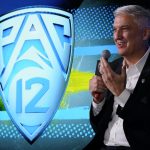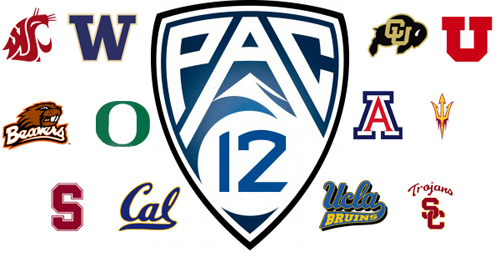The Hotline mailbag is published each Friday. Send questions to pac12hotline@bayareanewsgroup.com or hit me on Twitter: @WilnerHotline. Due to volume — and in some cases, the need for research — not all questions will be answered the week of submission. Thanks for your understanding.
Some questions have been edited for clarity and brevity.
What do you make of the Pac-12 seemingly being overlooked for additional spots (after the three ranked teams) in the men’s NCAA Tournament? — @round_mound34
This became a hot topic Thursday in Las Vegas after Colorado coach Tad Boyle expressed frustration with his team’s at-large position — CU is on the far outskirts of the NCAA bubble — and what he believes is an ESPN bias against the conference.
The two relevant comments from Boyle (via BuffZone.com):
— “I’m a little disappointed finishing fourth in a Power Five league, and we’re not even in the conversation.”
— “Quite frankly, I think there’s a big bias with the East Coast. And, quite frankly, ESPN. They’re talking about Virginia Tech. They’re squarely on the bubble. We’re not even in the conversation. I hope the committee is smarter than the people that are putting that thing together.”
First of all, the committee is smarter than the talking heads.
Second, ESPN is biased.
Now, part of that bias is the Pac-12’s fault. Half of Colorado’s games (16) were on the Pac-12 Networks, which have extremely limited distribution outside the conference borders. In terms of providing exposure for football and men’s basketball, they have been a colossal failure.
But let’s dispense with the ESPN bias and drill down on Colorado: Should the Buffaloes be in the at-large conversation?
The metrics at the heart of the NCAA selection process are not biased, and they see a clear distinction between Colorado and Virginia Tech.
In the NCAA’s all-important NET rankings:
Virginia Tech: No. 33
Colorado: No. 70
In the Pomeroy efficiency ratings:
Virginia Tech: No. 27
Colorado: No. 72
That difference helps frame our discussion:
The issue is not whether there’s a bias against Colorado, or the Pac-12. The issue is why the fourth-place team in one Power Five conference (Colorado) has substantially worse analytics than the seventh-place team in another Power Five conference (Virginia Tech).
Because if Virginia Tech were No. 70 in the NET rankings, instead of No. 33, ESPN would not be discussing the Hokies’ viability as a bubble team.
And on this front, we can offer insight: It’s all about November and December.
The foundation for the end-of-season NET rankings and the Pomeroy ratings is laid during the non-conference portion of the schedule. Those eight weeks account for less than 50 percent of a team’s season but carry outsized influence in the analytics that guide the selection committee’s decisions.
When leagues perform well in non-conference games, a multiplier effect is created within league play: You have more dates against other highly-rated teams and the floor rises for everyone.
When leagues perform poorly in non-conference games, the same process unfolds, only in reverse: The ceiling is lowered.
The Pac-12’s recent history shows a direct correlation between non-conference results and Selection Sunday success.
When the winning percentage outside of league play is below 70 (in italics below), the bid total is below four.
2012: 61.1 percent/two bids
2013: 74.8 percent/five bids
2014: 78.3 percent/six bids
2015: 72.5 percent/four bids
2016: 78 percent/seven bids
2017: 72.2 percent/four bids
2018: 69.8 percent/three bids
2019: 61.3 percent/three bids
2020: 73.9 percent/NCAAs canceled
2021: 74 percent/five bids
(Of note: The conference was on track for six bids in 2020.)
As for this season, well, the math is simple: The Pac-12’s non-conference winning percentage is 66.7 and, sure enough, the conference is on track for three bids.
But what about Virginia Tech?
Well, the ACC has the same non-conference winning percentage as the Pac-12. It also has 25 percent more teams (15), so the projected bid total should be higher. And it is, although by more than 25 percent: The latest projections from ESPN show the ACC collecting five bids but Virginia Tech as one of the first teams left out.
Here are three pieces of data to consider:
— Non-conference winning percentages for the Power Six leagues (including the Big East)
— Bid totals as projected by ESPN
— Projected bid totals as a percentage of the number of teams in the conference:
Big 12: 82.7 percent/six bids/60 percent of membership
Big Ten: 77.7 percent/nine bids/64 percent of membership
Big East: 76.5 percent/seven bids/64 percent of membership
SEC: 73.3 percent/six bids/43 percent of membership
ACC: 66.7 percent/five bids/33 percent of membership
Pac-12: 66.7 percent/three bids/25 percent of membership
The connection between non-conference performance the number of bids isn’t exact. It can’t be exact because of the disparities in scheduling and results, the human element in the selection process and the fact that conference affiliation isn’t part of the criteria for picking the at-large field.
We could drill down on individual cases, but the connection is close enough to account for the Pac-12’s bid total (relative to the competition) this year and over the sweep of the past decade.
From here, the central question for the Pac-12 — for both the coaches and the conference office — isn’t why the conference is tracking for just three bids.
It’s what more can be done to place teams in position to thrive in November and December.
It has (smartly) implemented non-conference scheduling standards in an attempt to improve NET rankings for the collective. But is there anything more that can be done to ensure stronger starts?
Win early, celebrate late.
After Arizona fired Sean Miller, four of the Wildcats’ six leading scorers transferred. Isn’t it past time to stop giving Miller credit for Tommy Lloyd’s success? And if Kerr Kriisa is out for the NCAAs, what is Arizona’s ceiling? — Yoni Cohen
Lloyd was named Pac-12 Coach of the Year and is a strong candidate for the national honors, so it appears he’s getting a sufficient level of credit.
Although the Wildcats lost several top scorers, the best players on this team are Miller’s recruits: Bennedict Mathurin, Azoulas Tubelis and Christian Koloko. I don’t see why it’s one or the other. Two things can be true: Miller left behind a talented roster, and Lloyd has done marvelous work with it.
The Kriisa situation is a huge problem … or maybe not.
We don’t know the extent of the ankle injury and the projected recovery time. I’m not going to speculate but would simply make the following case:
Arizona is good enough to win two games without him. Whether Kriisa returns in time for the second weekend of the tournament — and in what condition — is probably the key issue.
And consider this in the context of his recovery: The San Francisco and San Antonio regionals are Thursday-Saturday; the Chicago and Philadelphia regionals are Friday-Sunday.
If he’s able to return this month, every day of rest will count.
Cal hoops was a proud program with 25 years of success, routinely finishing in the top half of the Pac-12 and winning it once. Tons of talent and fun basketball. The last six or seven years have been awful. Bad, boring. Fan excitement is gone. Why isn’t athletic director Jim Knowlton firing coach Mark Fox? — @thomas_ob
I agree about the overall trajectory of the program but would place a significant amount of responsibility on the decision to hire Wyking Jones in the spring of 2017 by then-athletic director Mike Williams.
Simply put, it was one of the worst hires in recent Pac-12 history in either of the major sports, and it did far more damage to the program than the duration of Jones’ tenure (two seasons) would suggest.
In some regards, Fox’s first season was spent cleaning up the mess he inherited. Then came COVID.
It’s rare for a school to dismiss a coach after just three seasons, especially in a rebuilding situation. Then add the pandemic, Cal’s attempt to balance athletics with academics, the challenges posed by the transfer portal and the fact that the athletic director who made the Fox hire remains in charge.
I don’t think it’s unreasonable for the Bears to give Fox another season, but I don’t see a clear path to success, either. The roster simply doesn’t support elevated expectations.
Did Utah hire the right men’s basketball coach? A little early to judge perhaps, but what a tough year (worse than I thought). — @Michaelp9677
Worse than I expected, as well. We pegged the Utes for a middle-of-the-pack finish once Both Gach returned. Instead, they were one step above the basement. (And it was a deep basement.)
Keep the faith. Craig Smith’s track record and eye for talent suggest he’s up to the task.
If the Utes are in the same position this time next year, you might have cause for concern. But I expect an uptick in 2022-23, followed by a climb into the top half of the conference by the end of Year Three.
Let’s revisit in March of 2024.
Why can’t Stanford fire Jerod Haase? — @joshfried
Stanford seems to have lots of good pieces every season. Why can’t they put it all together? — @MogseyBogues
No doubt, coach Jerod Haase and his staff have recruited well over the sweep of his six seasons. But the whole is typically less than the sum of the parts.
The main issue is the lack of a plan and progress on offense, and the analytics bear that out: Not once in Haase’s tenure has Stanford finished in the top-100 of the Pomeroy offensive efficiency ratings.
They are too easy to defend; the players don’t get better; it’s a make-or-miss sport and Stanford misses far too often.
The Cardinal could fire Haase. It’s simply a matter of desire, and athletic director Bernard Muir made it clear with his statement Thursday that he supports Haase and believes the program is headed in the right direction.
Keep in mind that the pressure, either from fans and donors or from central campus, is one degree above non-existent. That leaves Muir with the room to proceed as he sees fit.
To be fair, Stanford has faced significant challenges with Covid and the transfer portal, but those are recent issues. They didn’t exist in Haase’s first four seasons, and the Cardinal was unable to attain relevance in that relatively calm stretch.
How many head coaches produce a mediocre product for their first six seasons and suddenly ascend in Years Seven or Eight? Not many. Not many at all.
In our view, it’s simple: Muir doesn’t want to fire his guy, and nobody has told he must.
Is there a more soulless arena in all of college basketball than T-Mobile Arena in Las Vegas? — @alcor805
I have no problem with T-Mobile as the setting for the Pac-12 tournament. In fact, it’s the best option for the conference, and there isn’t a close second.
The issue isn’t the facility or the city but the caliber of play: if the Pac-12 had more good teams — more ranked teams, more teams with designs on the NCAAs — and one or two superstar players, the crowds would follow.
Does Lincoln Riley live next to Tony Stark? — @WorkishFromHome
Riley’s new, 13,000 square foot, ocean-view digs in Palos Verdes Estates are nice and all. But the real benefit of that location is his proximity to the El Tarasco on PCH.
(Because El Tarasco is the best Mexican food in L.A. and @ me all you want.)
What goes better with a gray suit: brown shoes or black? — @waltasti
Given the location cited in your Twitter profile, perhaps you should consider green and yellow.
Support the Hotline: Receive three months of unlimited access for just 99 cents. Yep, that’s 99 cents for 90 days, with the option to cancel anytime. Details are here, and thanks for your support.
*** Send suggestions, comments and tips (confidentiality guaranteed) to pac12hotline@bayareanewsgroup.com or call 408-920-5716
*** Follow me on Twitter: @WilnerHotline
*** Pac-12 Hotline is not endorsed or sponsored by the Pac-12 Conference, and the views expressed herein do not necessarily reflect the views of the Conference.
Related posts:

(AP Photo/Ralph Freso, File)
Wilner Hotline – Pac-12 survival guide: The strategic merits of an alliance (or merger) with the Big 12
(AP Photo/Ralph Freso, File)
Wilner Hotline – Presidential Power Index: Which Pac-12 presidents have the greatest influence over the conference’s future
(AP Photo/Marcio Jose Sanchez)
Wilner Hotline – The Pac-12’s survival depends on the Big Ten, not the Big 12: Tracing the path to stability Pac-12 recruiting: Oregon lands three commits over Pac-12 rivals, but loses one to USC; Cal gets big TE recruit
Pac-12 recruiting: Oregon lands three commits over Pac-12 rivals, but loses one to USC; Cal gets big TE recruit
